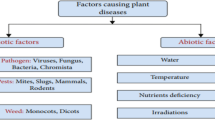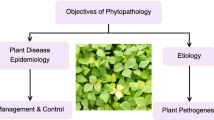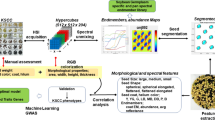Abstract
For the implementation of site-specific fungicide applications, the spatio-temporal dynamics of crop diseases must be well known. Remote sensing can be a useful tool to monitor the heterogeneity of crop vitality within agricultural sites. However, the identification of fungal infections at an early growth stage is essential. This study examines the potential of multi-spectral remote sensing for a multi-temporal analysis of crop diseases. Within an experimental field, a 6 ha plot of winter wheat was grown, containing all possible infective stages of the powdery mildew (Blumeria graminis) and leaf rust (Puccinia recondita) pathogens. Three high-resolution remote sensing images were used to execute a spatio-temporal analysis of the infection dynamics. A decision tree, using mixture tuned matched filtering (MTMF) results and the Normalized Difference Vegetation Index (NDVI), was applied to classify the data into areas showing different levels of disease severity. Classification results were compared to ground truth data. The classification accuracy of the first scene was only 56.8%, whereas the scenes from May 28th and June 20th achieved considerably higher accuracies of 65.9% and 88.6% respectively. The results showed that high-resolution multi-spectral data are generally suitable to detect in-field heterogeneities of crop vigour but are only moderately suitable for early detection of crop infections.






Similar content being viewed by others
Notes
Biologische Bundesanstalt, Bundessortenamt and CHemical industry. The BBCH-scale is a system for a uniform coding of phenological growth stages. The decimal code is divided into principal and secondary growth stages and is based on the cereal code developed by Zadoks et al., 1974.
References
Adams JB, Smith MO, Johnson PE (1985) Spectral mixture modeling: a new analysis of rock and soil types at the Viking Lander I site. J Geophys Res 91:8098–8112
Apan A, Held A, Phinn S, Markley J (2004) Detecting sugarcane ‘orange rust’ disease using EO–1 Hyperion hyperspectral imagery. Int J Remote Sens 25(2):489–498
Boardman, JW (1998) Leveraging the high dimensionality of AVIRIS data for improved sub-pixel target unmixing and rejection of false positives: mixture tuned matched filtering. In: Summaries of the 7th JPL Airborne Earth Science Workshop, edited by Jet Propulsion Laboratory, Pasadena, Vol. 97(1), 55–56
Carter GA, Knapp AK (2001) Leaf optical properties in higher plants: linking spectral characteristics to stress and chlorophyll concentration. Am J Bot 88:677–684
Du Q, French JV, Skaria M, Yang C, Everitt JH (2004) Citrus pest stress monitoring using airborne hyperspectral imagery. In: Conference Proceedings of the International Geoscience and Remote Sensing Symposia 2004, edited by IEEE (Anchorage, USA), Vol. VI, 3981–3984
European Commission (2002) Agriculture in the European Union, Statistical and economic information 2001. Brussels, Belgium
Franke J, Menz G, Oerke, E-C, Rascher U (2005) Comparison of multi- and hyperspectral imaging data of leaf rust infected wheat plants. In: Conference Proceedings of SPIE- European Remote Sensing Symposium, edited by SPIE (Brugge, Belgium), Vol. 5976–50, 1–11
Franke J, Heinzel V, Menz G (2006) Assessment of NDVI- differences caused by sensor-specific relative spectral response functions. In: Conference Proceedings of the International Geoscience and Remote Sensing Symposia 2006, edited by IEEE (Denver, USA)
Green AA, Berman M, Switzer P, Craig MD (1988) A transformation for ordering multispectral data in terms of image quality with implications for noise removal. IEEE Trans Geosci Remote Sens 26(1):65–74
Huete AR, Justice, C, VanLeeuwen W (1999) Modis Vegetation Index (MOD 13) Algorithm Theoretical Basis Document. Internet: http://modis.gsfc.nasa.gov/data/atbd/atbd_mod13.pdf (2006/11/10)
Jacobi J, Kühbauch W (2005) Site-specific identification of fungal infection and nitrogen deficiency in wheat crop using remote sensing. In: Proceedings of the 5th European Conference on Precision Agriculture, edited by J.V. Stafford (Wageningen Acadamic Publishers, Netherlands), 73–80
Larsolle A, Hamid Muhammed H (2005) Measuring crop status using multivariate analysis of hyperspectral field reflectance with application to disease severity and plant density. In: Proceedings of the 5th European Conference on Precision Agriculture, edited by J.V. Stafford (Wageningen Acadamic Publishers, Netherlands), 217–225
Laudien R, Bareth G, Doluschitz R (2004) Comparison of remote sensing based analysis of crop diseases by using high resolution multispectral and hyperspectral data - case study: Rhizoctonia Solani in sugar beet. Geoinformatics 2004. In: Proceedings of the12th International Conference on Geoinformatics, edited by S.A. Brandt (Gävle, Sweden), 670–676
Lelong CCD, Pinet PC, Poilvé H (1998) Hyperspectral Imaging and Stress Map** in Agriculture: A Case Study on Wheat in Beauce (France). Remote Sens Environ 66(2):179–191
Lorenzen B, Jensen A (1989) Changes in leaf spectral properties induced in barley by cereal powdery mildew. Remote Sens Environ 27:201–209
Malthus TJ, Madeira AC (1993) High resolution spectroradiometry: Spectral reflectance of field bean leaves infected by Botrytis fabae. Remote Sens Environ 45(1):107–116
Moschini RC, Pérez BA (1999) Predicting wheat leaf rust severity using planting date, genetic resistance, and weather variables. Plant Dis 83(4):381–384
Moshou D, Bravo C, West JS, Wahlen S, McCartney HA, Ramon H (2004) Automatic detection of ‘yellow rust’ in wheat using reflectance measurements and neural networks. Comput Electron Agric 44:173–188
Neudecker E, Schmidhalter U, Sperl C, Selige T (2001) Site-specific soil map** by electromagnetic induction. In: Proceedings of the 3rd European Conference on Precision Agriculture, edited by G. Grenier and S. Blackmore (Agro Montpellier, Montpellier, France), 271–276
Oerke E-C, Dehne H-W, Schönbeck F, Weber A (1994) Crop production and crop protection – estimated losses in major food and cash crops. Elsevier Science, 808 pp
Oerke E-C, Lindenthal M, Fröhling P, Steiner U (2005) Digital infrared thermography for the assessment of leaf pathogens. In: Proceedings of the 5th European Conference on Precision Agriculture, edited by J.V. Stafford (Wageningen Acadamic Publishers, Netherlands), 91–98
Shaw D, Kelley F (2005) Evaluating Remote Sensing for determining and classifying soybean anomalies. Prec Agric 6(5):421–429
West JS, Bravo C, Oberti R, Lemaire D, Moshou D, McCartney HA (2003) The potential of optical canopy measurement for targeted control of field crop diseases. Annu Rev Phytopathol 41:593–614
Williams AM, Hunt Jr ER (2002) Estimation of leafy spurge from hyperspectral imagery using mixture tuned matched filtering. Remote Sens Environ 82:446–456
Zadoks JC, Chang TT, Knozak CF (1974) A decimal code for growth stage of cereal. Weed Res 14:415–421
Acknowledgements
This study was carried out under sponsorship of the Research Training Group 722 ‘Information Techniques for Precision Crop Protection’, which is funded by the German Research Foundation (DFG). Special thanks go to Dr. Matthias Braun at the Center for Remote Sensing of Land Surfaces (ZFL) for the HyMap flight campaign and Albert Moll for assisting in programming the sensor simulation program.
Author information
Authors and Affiliations
Corresponding author
Rights and permissions
About this article
Cite this article
Franke, J., Menz, G. Multi-temporal wheat disease detection by multi-spectral remote sensing. Precision Agric 8, 161–172 (2007). https://doi.org/10.1007/s11119-007-9036-y
Published:
Issue Date:
DOI: https://doi.org/10.1007/s11119-007-9036-y




